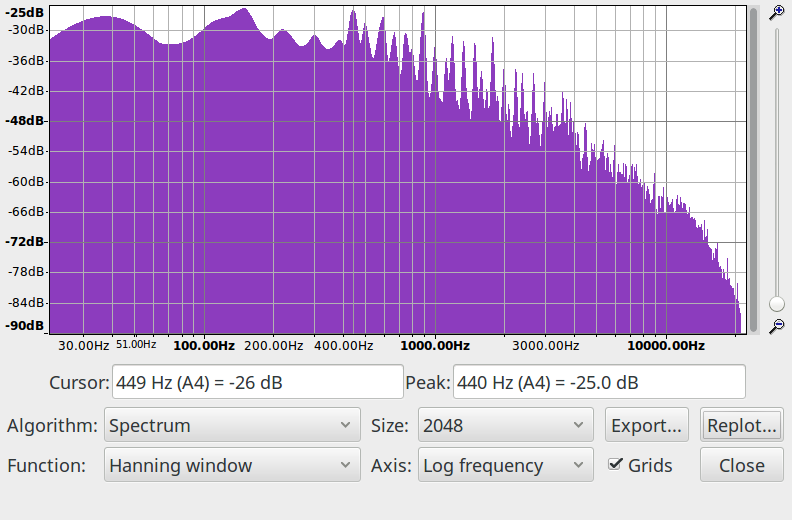I am a music listener not creator, I’ve recently read an article that states most music is recorded in 440hz but not all. I have watched an audacity video showing how to convert a music file to 432 hz which is supposed to be better for you. What I am not sure about is how to find out if the song i upload into audacity is in 440 hz or not, is there a simple way to do this that doesn’t require deep knowledge of music to get your head around please? Any help would be greatly appreciated. Thank you.
440Hz is the sound of the oboe at the beginning of the orchestra. Unless the oboe tone is there for analysis, I don’t know there is any good way to tell.
https://en.wikipedia.org/wiki/A440_(pitch_standard)
Koz
This is what 440 Hz looks like (Plot Spectrum):
and this is what it sounds like:
This is what music looks like (in this case, the finale of Mahler’s 1st symphony):
If you look carefully, there is a peak at about 440 Hz. However, you need to be aware that the accuracy of a spectrum plot depends on the “Size” setting. With “Size” set to 2048 (as in the above picture), the spectrum is an analysis of frequency bands with a width of about 21.5 Hz. Here is the numerical data showing the amplitude in 4 frequency bands around 440 Hz:
Frequency (Hz) Level (dB)
409.130859 -32.827454
430.664062 -26.801735
452.197266 -26.766785
473.730469 -32.721855
and the moon is made of cheese.
I’ve recently read an article that states most music is recorded in 440hz but not all.
I’d guess that more than 99% of (modern Western) music is tuned to the A=440 standard. If you’ve got Indian or far-Eastern music, you may have an entirely different scale.
Some instruments (horns & woodwinds for example) can’t be re-tuned and it’s not really practical to re-tune a piano. It’s easy to re-tune a guitar but I doubt you can even find an A=432 guitar tuner so you’d have to use an oscillator or computer. It’s not as unusual use non-standard tuning on a guitar, but the new tuning is usually from the 440Hz standard (so you don’t have to re-tune a piano to play along with the re-tuned guitar, you just play different notes).
Note that a song tuned to A=440 might not contain any A-notes. Most songs don’t use all 12 notes.
I’ve heard of some songs that were slowed-down or speeded-up, either accidently or intentionally, or that were mis-tuned and these may not correspond to any known-standard scale. As far as I know, mis-tuned recordings are usually only guitar, bass, or vocals (easy to mis-tune). I just found [u]5 Great Out-Of Tune Recordings[/u].*
What I am not sure about is how to find out if the song i upload into audacity is in 440 hz or not, is there a simple way to do this that doesn’t require deep knowledge of music to get your head around please?
It doesn’t require “deep knowledge,” but it does help to be a musician… If you can’t play-along in-tune with the recording, the song uses a non-standard tuning.
\
- There is some false information in that link…
As you can deduce, there are 25 other tunings one can play between A and Ab, that is, 439Hz, 438, 437, etc.
False! There is no reason that frequency has to be a whole number and there are an infinite number of pitches/tunings. The pitch of most natural sounds won’t fall “exactly” on a whole number.
And believe me, this makes a difference! Your ear is such a marvel of engineering that it actually can hear the difference between 440Hz and 439Hz.
False! Most people can’t hear a 1Hz difference (without a reference), and most people with perfect pitch can’t hear a 1Hz difference either. Perfect pitch means you can identify the note, and that requires an accuracy of about 3%.
If you play the two frequencies 1Hz apart at the same time, you can hear the beat frequency (that’s how you tune a guitar to a tuning-fork or piano).

